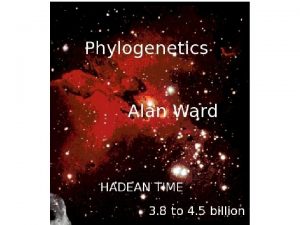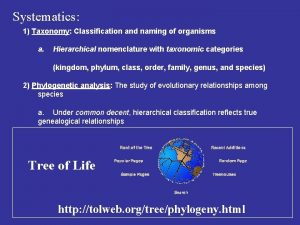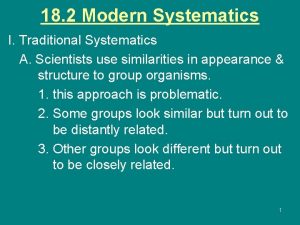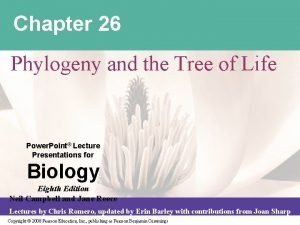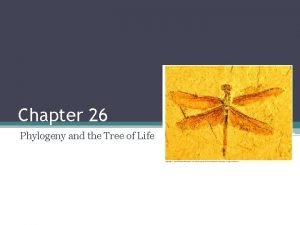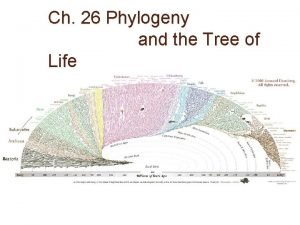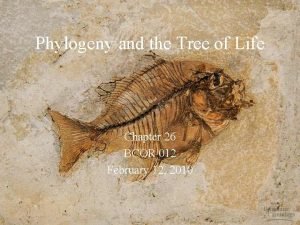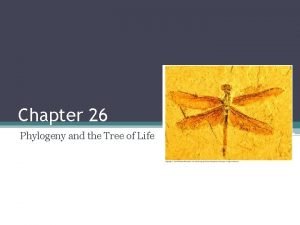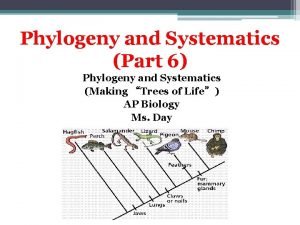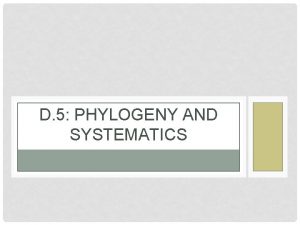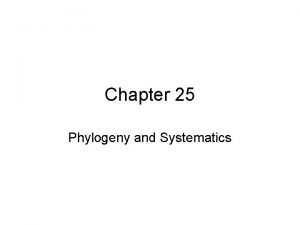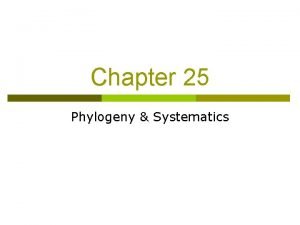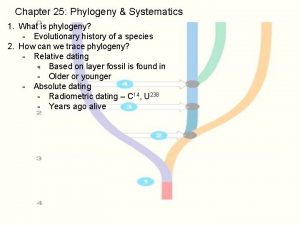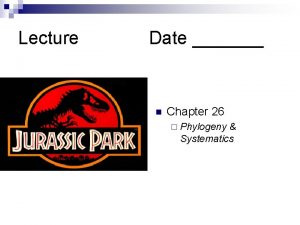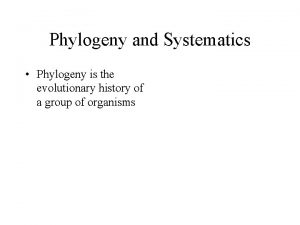p Chapter 25 Phylogeny Systematics Phylogeny p p










- Slides: 10

p Chapter 25 – Phylogeny & Systematics

Phylogeny p p p The evolutionary history of a species Systematics: the study of biological diversity in an evolutionary context; study morphological and biochemical relationships of present-day and extinct species Molecular Systematics: uses comparisons of DNA, RNA, and other macromolecules to infer evolutionary relationships between genes and genomes

The Fossil Record p p p The ordered array of fossils, within layers or strata, of sedimentary rock Help to determine phylogeny but only if age can be determined Paleontologists – study fossils

Morphological and Molecular Homologies p p Organisms that share very similar morphologies (both structural and molecular) or similar DNA sequences are likely to be more closely related than those with different structures or sequences. Must sort out analogy from homology. Convergent evolution can produce very similar organisms. It is critical to identify these relationships to reconstruct accurate phylogenies.

Taxonomy An ordered subdivision of organisms into categories based on a set of characteristics used to assess similarities and differences. p Linnaeus p Binomial nomenclature – Genus and specific epithet (species) p Names are latinized p

Classification and Phylogeny p p p Phylogenic trees – branching diagrams used to depict evolutionary relationships Constructed from a series of dichotomies (2 -way branch points) where each branch point represents the divergence of two species from a common ancestor “Deeper” branch points represent more divergence

Systematics p p p Cladistics - the analysis of how species may be grouped into clades Cladogram – forms the basis of a phylogenic tree, but not a phylogenic tree Clade – a group of species that includes ancestral species and all of its descendants n n n Monophyletic – consists of the ancestral species and all descendants Paraphyletic – consists of an ancestral species and some of the descendants Polyphyletic – grouping of several species that lack a common ancestor

Constructing a Cladogram p p p Shared primitive character – shared beyond the taxon under definition (backbone in mammals) Shared derived character – unique to a particular clade (hair in mammal clade) Must designate an outgroup, species closely related to the ingroup, the species under study Use various homologous structures to define groups, must predate the divergence of both the outgroup and ingroup Construct a cladogram using the following organisms: lamprey, leopard, tuna, lancelet, turtle, salamander. Include the characteristic that separates each clade from its outgroup.

Phylogenic Trees Phylograms – length of a branch reflects the number of changes that have taken place in a particular DNA sequence in that lineage p Example – used hedgehog genes using Drosophila as the outgroup to show the evolution of the gene p

Phylogenic Trees p Ultrametric trees – same as a phylogram, but shows chronological time as compared to rate of evolution
 Systematics vs taxonomy
Systematics vs taxonomy Synapomorphy
Synapomorphy Traditional systematics
Traditional systematics Systematics deals with
Systematics deals with Modern systematics try to group organisms based on
Modern systematics try to group organisms based on Chapter 26 campbell biology
Chapter 26 campbell biology Chapter 20 phylogeny and the tree of life
Chapter 20 phylogeny and the tree of life Monophyletic group
Monophyletic group Chapter 26 phylogeny and the tree of life
Chapter 26 phylogeny and the tree of life Phylogeny and the tree of life chapter 26
Phylogeny and the tree of life chapter 26 Chapter 26 phylogeny and the tree of life
Chapter 26 phylogeny and the tree of life
